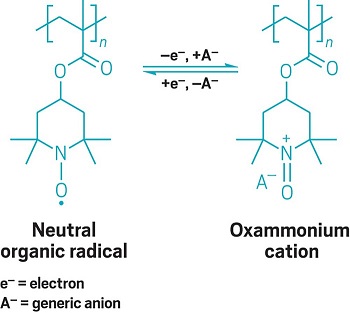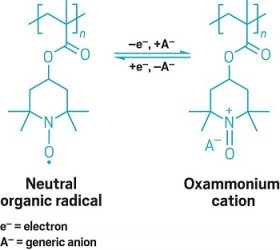Redox mechanism study reveals unexpected role for cations
by Mitch Jacoby
DECEMBER 2, 2018 | APPEARED IN VOLUME 96, ISSUE 48
ready supply of thin, lightweight, flexible batteries could push development of stretchable and foldable electronics into high gear. For that reason, researchers have combed through libraries of organic compounds looking for high-performance electronic conductors.

Organic radical polymers—molecules with radical sites hanging off a polymer backbone—recently jumped ahead of the pack, showing themselves to be promising electrode materials for fast-charging batteries. But the mechanism by which these polymers conduct charge has remained unclear, hampering their development.
To sort out the details, especially the role of ion transport, a team led by Jodie L. Lutkenhaus of Texas A&M University devised a quartz crystal microbalance method to monitor nanogram-scale mass changes in a polymer electrode during charging cycles (Nat. Mater. 2018, DOI: 10.1038/s41563-018-0215-1).
The electrochemical system consisted of PTMA, a poly(methyl methacrylate)–based polymer with pendant nitroxyl radical groups, infused with common lithium electrolyte solutions. The group found that as anions latch on to radical sites during redox reactions, sometimes the process causes unexpected expulsion of lithium ions from the polymer.
That phenomenon, which can affect electrode performance, is controlled by choice of anion, electrolyte concentration, and reaction kinetics, handles that can be used to tune these materials for applications, the team says.

